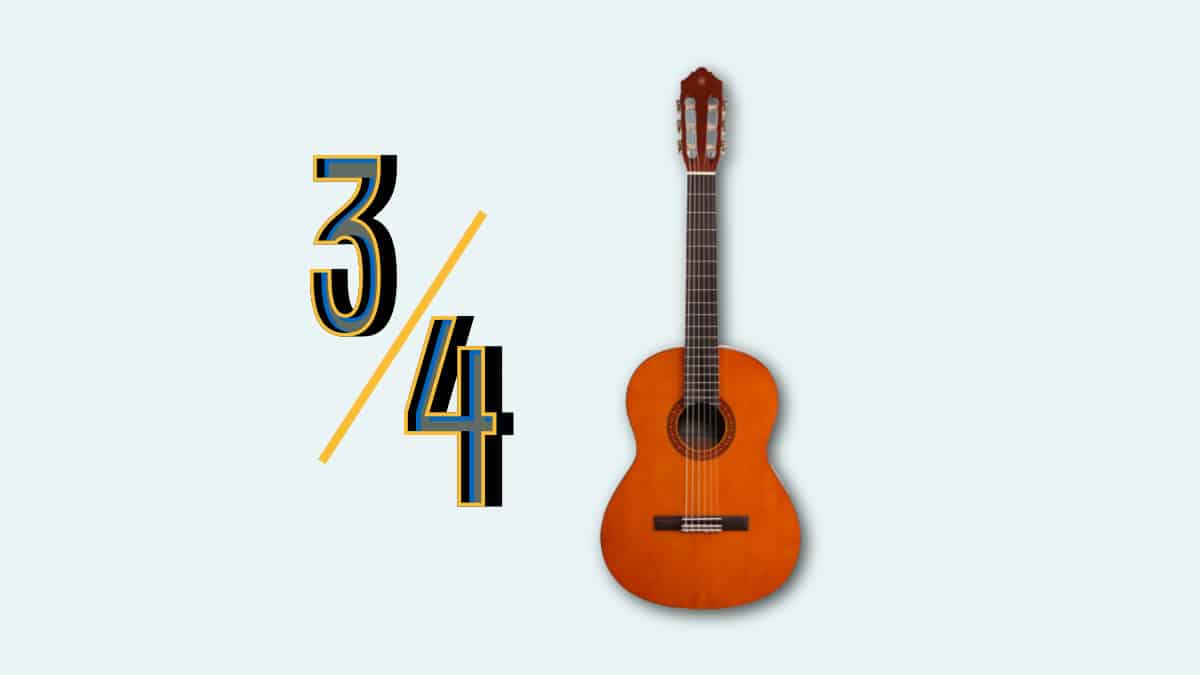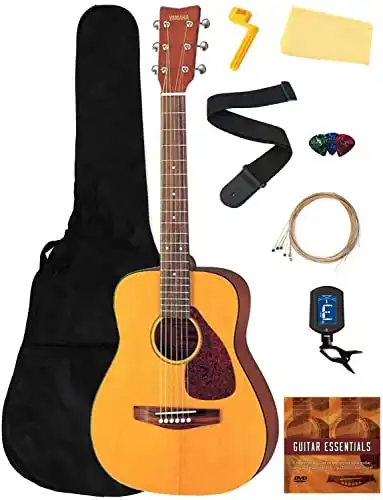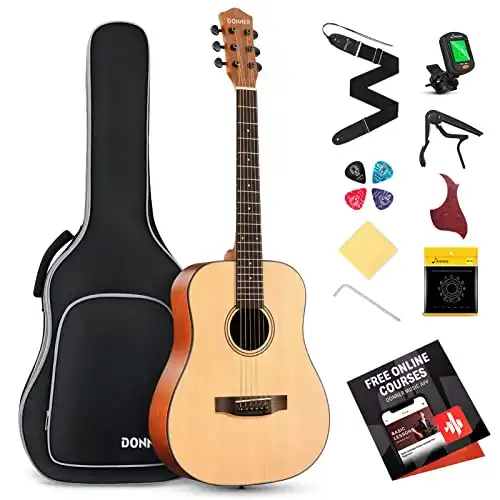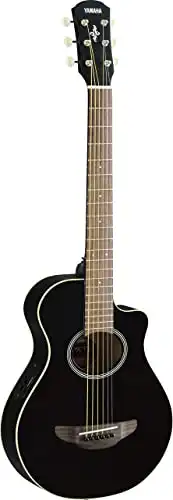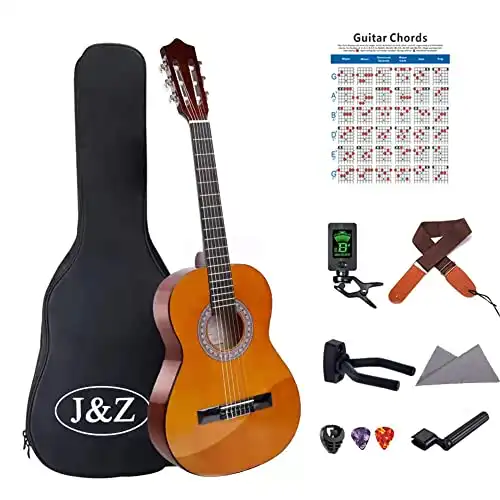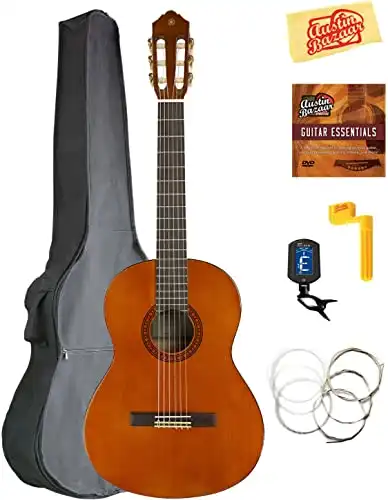I’ve been playing guitar for over 20 years, and I can still recall those moments of frustration as a beginner, trying to wrap my fingers around the fretboard to hit the right strings.
If you’re just beginning, or getting your kid started, choosing a 3/4 acoustic guitar from the start can make the learning process much easier and less achy on the hands.
Even if you’re a seasoned guitarist, a 3/4 acoustic guitar could be useful as a travel guitar or a good option for someone with small hands.
As someone with fairly small hands myself, I’ll share my insights on what 3/4 guitars are all about and review 5 solid choices to help you find the best option for your needs.
What Is a 3/4 Guitar?
Here’s a simple explanation. A standard-sized guitar is around 40 inches in total length. A 3/4 guitar is a bit shorter—about 36 inches long.
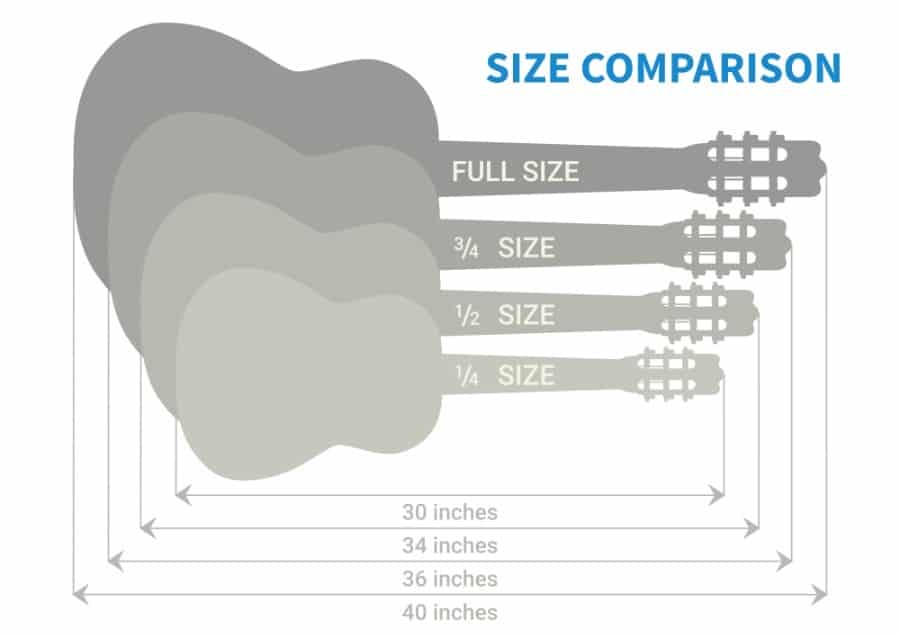
Now here’s where it gets a little more complicated. The “3/4” doesn’t actually refer to the length of the whole guitar. It refers to the total scale length, or the length from the bridge to the guitar head (basically from the sound hole to the tuning pegs).
The scale length is probably a more important measurement when choosing a guitar because that’s the area you’ll be actively wrapping your fingers around while sliding up and down.
A 3/4 guitar has a shorter scale (around 23 inches) which means it’s easier to get your hands in the right position without over-stretching. The strings also fit a tad more loosely.
It’s a good idea to check the scale length of any guitar you buy—if the scale length is more than 25 inches, it still counts as a full-length guitar.
This video explains a little more about the pros and cons of different scale lengths:
Are 3/4 Guitars for Adults?
3/4 acoustic guitars are recommended for kids of about 8 years old and upwards. But they can be suitable for adults too. It really comes down to ease of playing and personal preference.
They’re generally pretty good for adults who have smaller hands, or for adult guitarists who want a smaller instrument to take with them when they travel (although a 3/4 guitar is not technically a “travel” guitar).
Why Should I Get A 3/4 Guitar?
As someone with fairly small hands, I can definitely recommend a 3/4 guitar for easier and less painful chord fingering and possibly quicker learning.
The easier reach is especially helpful for styles that use a lot of bar chords or soloing, like playing the blues, for example.
No, a 3/4 guitar won’t look tiny in your hands. Yes, it can sound every bit as great as a full-length guitar.
You’d be surprised at how much difference that 2” makes when you’re on the road and trying to fit a guitar into a car.
I learned this the hard way – and ended up with a snapped guitar neck after hitting a speed bump too hard!
What Should I Look For In a 3/4 Guitar?
If a 3/4 guitar sounds like the right choice for you, here are some things you should consider when shopping for one.
Guitar Action (& Adjustability)
The action of a guitar is the space between the fretboard and the strings, or how far you have to push the strings down to make a note or chord.
When you’re first starting out, that space can seem like the Grand Canyon when you’re trying to hold a chord!
A lower action is better not only for beginners and kids, but it also allows for easier chord transition in intermediate and advanced players.
An adjustable truss rod is also a good thing to look out for. This is a thin metal rod that runs inside the guitar neck. Its function is to prevent the neck from bending against the tension that the strings exert on it.
It’s great to be able to adjust the tension in the neck in case you wish to switch from thinner to thicker strings, or the other way around.
Having an adjustable truss rod also gives you the ability to make small adjustments to the guitar action (by bending the neck ever-so-slightly).
Guitar String Type
Nylon strings are a good choice for kids to learn with. Their fingers will definitely still feel it, but it’s a better start than the cutting feeling of steel strings.
If you aren’t strictly a classical player, you might prefer the sturdier feel and brighter sound of steel strings.
Cutaway Guitars
Guitarists who want more reach on the fretboard may choose a cutaway design.
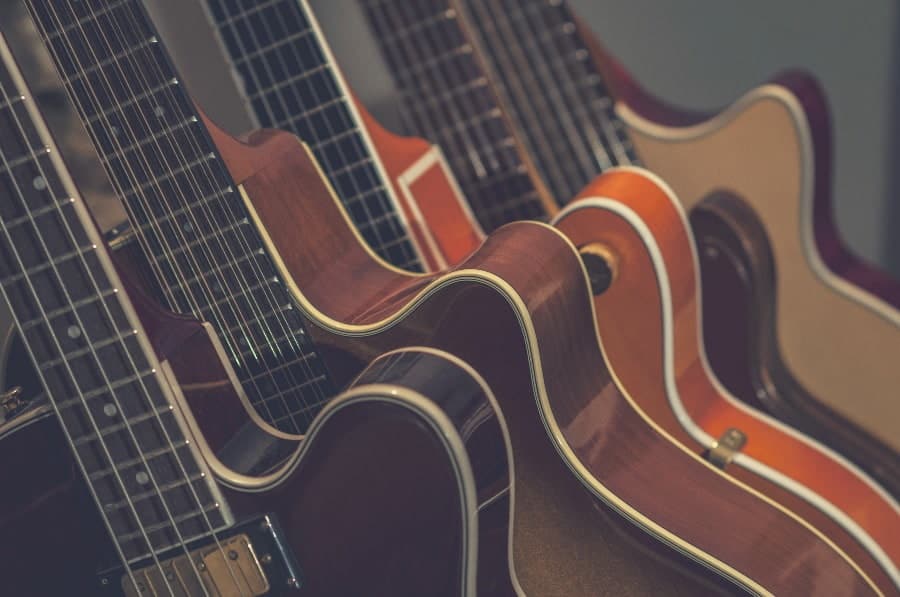
When you look at a full-body acoustic guitar straight-on, it’s symmetrical. Both sides of the neck where the body meets it are at the same height.
A cutaway guitar is asymmetrical. One side has an indentation (like the image above) to allow a player’s hand to reach the really high notes on the fretboard.
This is helpful for various styles of music, including fingerstyle.
5 Best 3/4 Acoustic Guitars
If you’ve decided that a 3/4 guitar is the way for you to go, here are 5 solid options.
Top Pick: Yamaha JR1 3/4-Scale Acoustic Guitar Bundle
The Yamaha JR1 3/4-Scale Acoustic Guitar Bundle is great for beginners but high enough quality for more advanced guitarists too. It comes with everything you need to literally take it out of the bag, sit down and play.
Yamaha makes a lot of good acoustic guitars.
I’ve chosen the Yamaha JR1 as my top pick, because it’s great for beginners but high enough quality for more advanced guitarists too.
It’s not the cheapest one on the list, but it’s very reasonably priced, and you won’t have to spend much money on accessories (except maybe a strap). It comes with everything you need to literally take it out the bag, sit down and play.
The extra-short scale length of 21 ¼” would suit kids, as well as adults with smaller hands.
Yamaha has crafted the JR1 out of a variety of woods (including a rosewood fretboard and a meranti body) which gives it a full-bodied, folksy sound that some minis don’t get right.
The dreadnought design means it’s easy to set the Yamaha JR1 up for both right-handers and left-handers.
It also has an adjustable truss rod so you can modify the tension in the guitar neck to be just right for you (or your child).
The versatility, superb sound, and very happy reviewers made it easy to choose this one as the best overall 3/4 guitar.
What I Like
- Comes with several accessories
- Extra-short scale length of 21 ¼”
- Bright steel string sound
- Rosewood gives a full-bodied, folksy sound
What I Don’t Like
- No acoustic-electric function
- Steel strings may be hard on a beginner’s fingers
The Yamaha JR1 3/4-Scale Acoustic Guitar Bundle is great for beginners but high enough quality for more advanced guitarists too. It comes with everything you need to literally take it out of the bag, sit down and play.
Best 3/4 Guitar for Beginners: Donner 36″ 3/4 Size Dreadnought Acoustic Guitar Package
The Donner 36" Acoustic Guitar Package is reasonably priced with everything you need to start playing guitar. Let's not forget about the look. I love the eye-catching element of the dark die-cast steel tuning heads.
This full package is a really great starting point for a beginner wanting to learn to play guitar. It comes with a tuner, gig bag, strap, capo, pickguard, 4 picks, polishing cloth, and an extra set of strings.
It’s very reasonably priced for what you’re getting, and it’s well-crafted from attractive African mahogany and spruce. The dark die-cast steel tuning heads also add an eye-catching element.
The downside is that the truss rod isn’t adjustable. This means that if you want to switch to thicker strings, the neck may bend slightly due to tension, and you wouldn’t be able to compensate by adjusting the truss rod.
Also, the placement of the guitar strap button is a little unusual. It’s great for right-handers, but it seems a little like it may fall off very easily with left-handers.
Bronze strings are actually a really nice touch for beginners. They’re a little softer than steel, but harder than nylon. They also resist corrosion pretty well.
The great value this package provides and the softer-than-usual string choice is what makes it my ideal choice for the best 3/4 guitar for beginners.
What I Like
- Softer bronze strings
- Comes with full range of accessories
- Reasonable price
- Removable pickguard
What I Don’t Like
- The strap button is may not work well for left-handers
- Truss rod isn’t adjustable (can’t change the neck tension)
The Donner 36" Acoustic Guitar Package is reasonably priced with everything you need to start playing guitar. Let's not forget about the look. I love the eye-catching element of the dark die-cast steel tuning heads.
Best 3/4 Size Acoustic-Electric Guitar: Yamaha APXT2 3/4-Size Acoustic-Electric Guitar
The Yamaha APXT2 3/4-Size Acoustic-Electric Guitar has a unique and attractive body shape and comes in several different finishes and colors so you can pick a style that best suits you. Personally, I love the versatility of this acoustic-electric guitar, and the built-in tuner and cutaway make it extra convenient.
Being able to plug your guitar into an amp is handy if you ever need more volume for a performance or a jam session.
Personally, I love the versatility of an acoustic-electric guitar, but I remember not caring much about that factor as a kid. (Related: Here are some reviews of electric guitars for kids.)
This guitar has a unique and attractive body shape, and comes in several different finishes and colors so you can choose one to suit you. (Some of the finishes are exotic wood, so they’ll be a little more pricey.)
It comes with Yamaha’s “Acoustic Resonance Technology” pickup – a preamp whose sound has been praised by buyers.
The built-in tuner and cutaway make it extra convenient and versatile. For those looking for the best 3/4 acoustic-electric guitar, this one comes with all the add-ons at a relatively decent price.
What I Like
- Nice electric pickup so you can “plug in” to an amp or PA system
- The cutaway allows for more reach
- Built-in tuner for convenience
- Adjustable truss rod (with an allen wrench)
What I Don’t Like
- The steel strings it comes with are not the best quality
- The tuning pegs are not great and may need to be replaced
The Yamaha APXT2 3/4-Size Acoustic-Electric Guitar has a unique and attractive body shape and comes in several different finishes and colors so you can pick a style that best suits you. Personally, I love the versatility of this acoustic-electric guitar, and the built-in tuner and cutaway make it extra convenient.
Best 3/4 Guitar for Child: J&Z Beginner Acoustic Classical Guitar 3/4 Junior Size
This J&Z junior-size guitar is a great beginner's option for kids. It comes with various accessories, including a guitar polishing wipe and a waterproof gig bag, giving your child the essentials they need to learn how to look after their guitar from the start.
The J&Z wins the top spot for best 3/4 guitar for child guitar players.
It could be well-suited to adults too, but it has some features that give it the thumbs-up for kids specifically.
The nylon strings will be easier on a child’s hands, so this is great as a first guitar.
It comes with various accessories, including a guitar polishing wipe and a waterproof gig bag, which are super for your child to start learning how to look after a guitar from the start.
This guitar is ultra-cheap, especially considering the added accessories—if your kid bumps it, scratches it, or outgrows it, it won’t be a huge deal.
If you’re looking for a budget option just to get your child started, this could be an excellent choice.
What I Like
- Very nice price
- Nylon strings are easier on the fingers
- All accessories included
What I Don’t Like
- The bag isn’t padded
- Not the highest quality
This J&Z junior-size guitar is a great beginner's option for kids. It comes with various accessories, including a guitar polishing wipe and a waterproof gig bag, giving your child the essentials they need to learn how to look after their guitar from the start.
Best 3/4 Classical Guitar: Yamaha CGS103A 3/4-Size Classical Guitar Bundle
If you’re looking for a well-made classical guitar that will deliver a smooth sound and not break the bank, the Yamaha CGS103A 3/4-Size can do the job admirably. The nylon strings are added plus, as they're softer on the fingers. The main downside is the absence of a truss rod for adjusting.
If you’re looking for a well-made classical guitar that will deliver smooth sound and not break the bank, this one could do the job admirably.
It’s got solid reviews, from both adult guitarists and parents who’ve bought it for their kids.
The nylon strings (which are traditional for a classical guitar) are softer on the fingers than steel strings.
They also give it that light, mellow sound that classical guitars are known for.
The main downsides are the absence of a truss rod for adjusting, and the fact that unlike every other option on this list it comes with no accessories.
What I Like
- Nylon strings are easy on the fingers
- Suitable for both left and right-handed players
- Impressive tone and volume
What I Don’t Like
- No truss rod
- No accessories included
If you’re looking for a well-made classical guitar that will deliver a smooth sound and not break the bank, the Yamaha CGS103A 3/4-Size can do the job admirably. The nylon strings are added plus, as they're softer on the fingers. The main downside is the absence of a truss rod for adjusting.
Conclusion
Every guitar on this list could be a decent option.
The final say comes down to you. Personal preference and who’s actually going to be playing the guitar make quite a big difference.
Nylon strings are super for kids, to get their hands used to the feeling of holding chords without hurting too much.
If you want more reach, choose a cutaway-style guitar instead of a full-body.
If you’re planning to perform on stage, an acoustic-electric is probably best. For around a campfire or on the road, a normal 3/4 acoustic guitar will do just fine.
When it comes to the best 3/4 acoustic guitar, my personal favorite is the Yamaha JR1 3/4-Scale Acoustic Guitar Bundle. It can work for both kids and adults, it’s designed to suit both left and right-handers, and it comes with a full range of accessories.
Whichever one you choose, hopefully your new 3/4 guitar adds an extra element of ease and excitement to your guitar playing.
Thanks for visiting!






